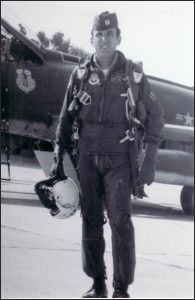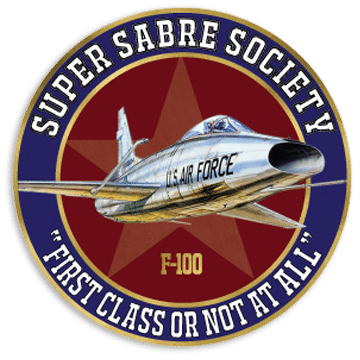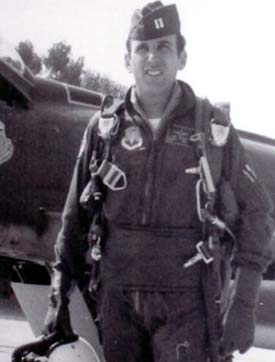Thomas Treuhaft flew the F-100 with the 112th Tactical Fighter Squadron/180th Tactical Fighter Group of the Ohio Air National Guard.
Tom Treuhaft – Caterpillar Club Story
 On 23 January 1976, while deployed to Nellis AFB with the 112th TFS/180th TFG of the OH ANG for Red Flag Exercises, I was number three in a four-ship on a low-level, armed recce mission with Mk-76 practice bombs.
On 23 January 1976, while deployed to Nellis AFB with the 112th TFS/180th TFG of the OH ANG for Red Flag Exercises, I was number three in a four-ship on a low-level, armed recce mission with Mk-76 practice bombs.
Soon after starting to recce the road, Lead spotted an APC (Armored Personnel Carrier) on the road and called for my element to hit it. My wingman and I popped up for a low-angle dive bomb delivery. At the top of the maneuver, I rolled and pulled the nose down toward the target. I was steep and added back pressure on the stick to bring the nose up to the target and establish the proper bomb delivery parameters. Nothing happened. I pulled harder, nothing happened. I pulled even harder, NOTHING HAPPENED.
OH SHIT!!!! I’m getting out of this thing—NOW!!!!
Handgrips raise. Triggers squeeze.
I had a blurred vision of red and yellow flames, and smoke as the rocket seat fired. The windblast BROKE the chin strap and my helmet was blown off. The next thing I knew, I was lying in the desert and could move only enough to slowly release my parachute. Lucky for me there was no wind and that I did not bounce my head off a nice soft rock. I knew when I got out that I was pushing the envelope for a safe ejection, but it was eject or go in with the bird. I found out later that I got out at approximately 200 feet BELOW the safe ejection envelope.
I broke almost every bone in my torso including my back, punctured my left lung, and had lots of internal bleeding. Lucky again for me, a Jolly Green was also on a training mission and was in the process of aerial refueling. Lead called “King’s X … pilot down,” but it still took about 30 minutes for the rescue chopper to get to me. By that time, I was very close to checking out. After days in the ICU, months in hospitals, and months in rehab, I got back on flight status in September 1976. I flew the Hun until our unit replaced them at the end of 1979. There were many theories as to what caused old #073 to act the way she did, but she was in too many small, charred pieces [slab components, actuators, etc., were not complete enough to be analyzed] to come up with a conclusive cause. ~Tom Treuhaft



